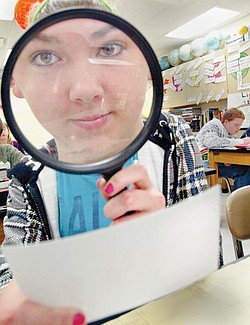CSI: GIRARD
LOOKING CLOSER: Alexis Cloud, an eighth-grader at Girard Junior High School, gets a closer look at fingerprints during a class project to find out who may have stolen some money from a teacher by using crime-solving techniques seen on popular TV shows such as “CSI.”
Class exercise gives junior high students insight into how police officers solve crimes
By VIRGINIA ROSS SHANK
VINDICATOR CORRESPONDENT
Instructor Joseph Radza set the crime-scene investigation into motion earlier this month when he told the students in his Pathways to Honors course at Girard Junior High School that $20 had been taken from his desk.
Now it’s up to the 17 crime-scene investigators in that class to determine who committed the act.
For the past several weeks, the investigators have been working diligently to solve the “mock crime” and close the case as quickly as possible.
“I think I have some idea who it is,” said Arielle Terry, 13, of Girard. “I have it narrowed down to the two mostly likely people. I’m still looking at the evidence though. We’ll see.”
Radza, who has been teaching the Pathways course for the past four years, said he tries to develop a project each year to help his students develop their problem-solving skills.
At the beginning of the school year, he asked the youths in what kind of project they were interested, and many said they wanted to do something involving crime solving.
Radza chose one student to act as the criminal and swore that child to secrecy. The drama unfolded.
Monday morning the investigators continued working to eliminate one another from the pool of suspects. They said they expect to name the culprit by the end of this week.
“A lot of the students watch ‘CSI’ and other crime shows and have a real interest in how the police do their jobs and what types of things crime-scene investigators look for,” Radza explained. “So this is what we’re working on: solving a fictional crime. It’s been quite a learning experience so far, and the kids have all responded very well to it. They’ve worked really hard. It will be interesting to see what they come up with.”
Radza first introduced the students to some basic facts. He told them that on Oct. 1, leaving the door unlocked, he left his classroom after school to go to the office sometime around 3 p.m. When he returned, about 10 minutes later, he found his desk in disarray and $20 missing from it.
He immediately notified Girard Patrolman Ron Schnarrs, who also serves as the juvenile resource officer at the school. The police assisted the students in collecting evidence, including fingerprints and hair and thread samples found at the scene. Crime-scene photographs were taken, and a handwritten note left at the scene with the message,“Our Revenge,” on it has been analyzed.
It was determined the theft likely was an inside job and that it was committed by one of the Pathway students. The “guilty party” has participated in the program along side his/her peers as one of the investigators.
The students researched crime-scene investigation information and protocol online, read and studied various crime-solving handouts and participated in a presentation by Schnarrs, who has continued assisting them in their investigation.
The evidence was stored in plastic bags and placed on the evidence table for easy access during the investigation. Hair, fingerprint and handwriting samples were collected from each class member.
“You have to look really close at all the evidence,” explained 13-year-old Dean Clingerman of Girard. “You rule out people based on the evidence you have. Then you try to narrow it down to the person most likely to be the one who did it. It really makes you think.”
Dean said based on the evidence he has examined, the suspect has longer hair that is likely red or light- to medium-brown. He also narrowed in on the “type” of fingerprint the suspect likely has based on typical patterns found on most people’s fingertips.
Schnarrs said once a suspect is named he intends to arrest the student — complete with handcuffs — take the individual into custody and charge him/her with the crime.
“But remember, this is just a mock-crime program,” Radza said. “The student will be returned to class quickly.”
And then the true “criminal” will be revealed.
For students such as Alexis Cloud, 13, of Girard, the experience has given them a better look at the work many police officers do daily.
“A project like this really makes you think things through,” Alexis explained. “It’s really showed me what the police have to do to solve a crime and the process and everything. It can be a lot of work, and it takes a lot of time sometimes. But it’s really interesting.”
 43
43

